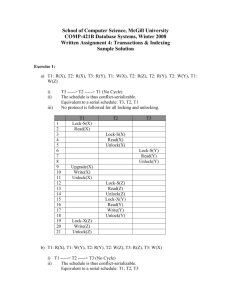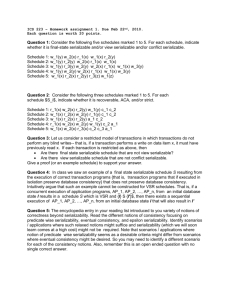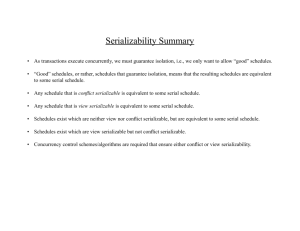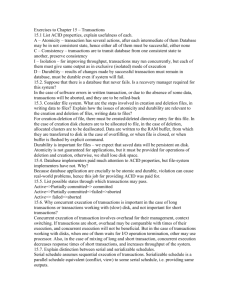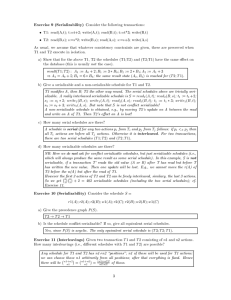Shared and exlusive locks
advertisement
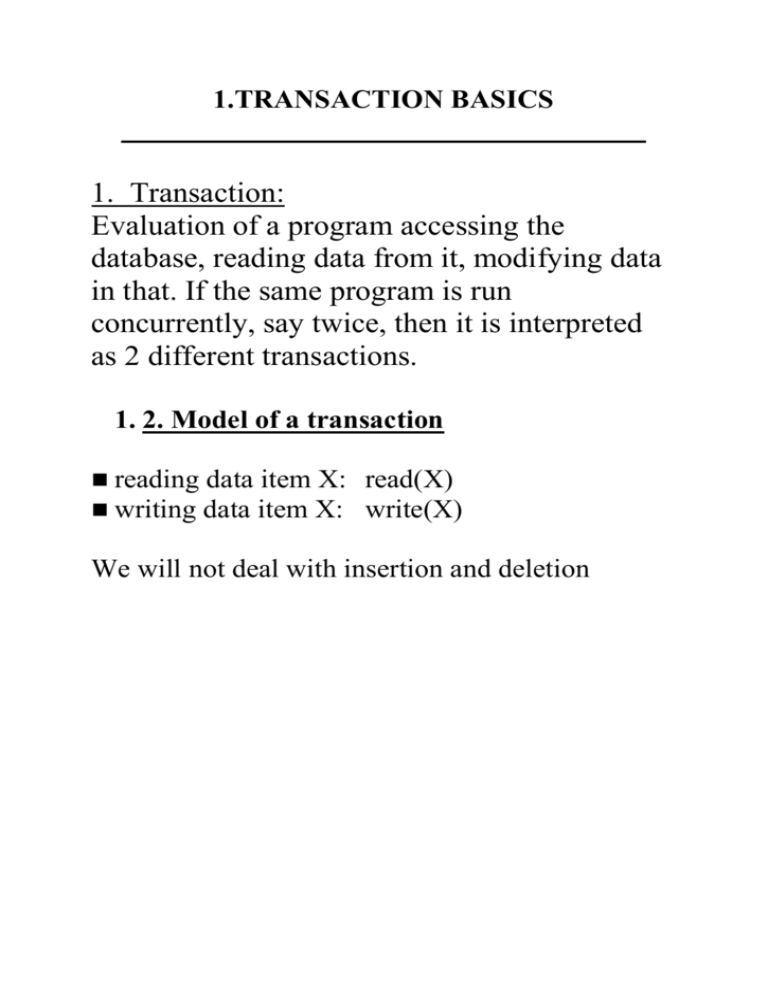
1.TRANSACTION BASICS _____________________________________ 1. Transaction: Evaluation of a program accessing the database, reading data from it, modifying data in that. If the same program is run concurrently, say twice, then it is interpreted as 2 different transactions. 1. 2. Model of a transaction reading data item X: writing data item X: read(X) write(X) We will not deal with insertion and deletion 1.TRANSACTION BASICS _____________________________________ Example: reserving seats T1: concels N seats on flight1, X, and reserves N seats on flight2, Y T2: reserves M seats on flight1 T1 read(X); X:= X-N; write(X); read(Y); Y:=Y+N; write(Y); T2 read(X) ; X:= X+M; write(X) ; 1.TRANSACTION BASICS _____________________________________ 1. 3. Using the database concurrently many transactions at the same time optimizing CPU work ( Input/Output actions ) SHARING CPU T1 1 T1 T2 1 CPU T1 T2 T2 2 CPUs 1.Transactions basics ______________________________________ Why we need to check concurrent transactions? Example: T1 T2 read(X); X:= X-N; _____________________________ read(X) ; X:= X+M; ______________________________ write(X); read(Y); ______________________________ read(X) ; ______________________________ Y:=Y+N; write(Y); Questions: - read(X): where we get the value for X in T1, and where in T2? - Which data is lost? - Is the database consistent? 1.Transactions basics ______________________________________ Example: T1 T2 read(X); X:= X-N; write(X); ______________________________ read(X) ; X:= X+M; write(X) ; _____________ _________________ read(Y); ************ system failor Question: from where we get the value for X in T1, and from wheer in T2? Here T1 is aborted from some reason. Then it must be rolled back. But T2 already finished, the user is informed.. 1.Transactions basics ______________________________________ Example: Problem with using aggregate functions T1 read (X); X:= X-N; write(X); T3 sum:=0; read (A) ; sum:=sum+A; ….. ….. ….. read (X) ; sum:=sum+X; read (Y) ; sum:=sum+Y; read (Y); Y:=Y+N; write(Y); Conflict eqvivalency, see file apr.15. 3.Transactions schedules 3. 3. VIEW eqvivalent schedules Example: Decide whether the following schedules are view eqvivalent, or not, explain. SCHEDULE1: T1 T2 read(X); X:= X-N; write(X); read(Y) ; Y:=Y+N; write(Y); read(X); X:=X+M; write(X) ; SCHEDULE2:____________________________ read(X) ; X:= X-N; write(X) ; read(X) ; X:=X+M; write(X) ; read(Y) ; Y:=Y+N; write(Y) ; 3.Transactions schedules Example: Decide whether the following schedules are view eqvivalent, or not, explain. SCHEDULE1: T1 T2 read(X); X:= X-N; read(X); X:=X+M; write(X); read(Y) ; write(X) ; Y:=Y+N; write(Y); SCHEDULE2: T1, T2(below), read(X); X:= X-N; write(X); read(Y) ; Y:=Y+N; write(Y); read(X); X:=X+M; write(X) ; SCHEDULE3:T2,T1 3. Transactions schedules Example: Decide whether the following schedules are view eqvivalent, or not, explain. T1 read(X); X:= X-N; T2 read(X); X:=X+M; write(X); read(Y) ; write(X) ; Y:=Y+N; write(Y); T1 read(X); X:=X+M; T2 read(X); X:= X-N; write(X); write(X) ; read(Y) ; Y:=Y+N; write(Y); 3. Transactions schedules Summary: There are schedules being (conflict or view) eqvivalent to some serial order. These schedules are called serializable. However there are schedules which are not serializable, that is, there does not exist such a serial schedule, being eqvivalent (view or conflict) to the given one. The schedule is surely correct, if it is serializable 3. Tranzaction schedules How to check serializability? Precedence graph protocols: keeping given rules in the protocol, they automatically ensure serializability. - Two phase protocols - Time stamp based protocols Transactions scheduling Checking serializability: Precedence graph (does not work in practice) Vertices: TRANSACTIONS (BY THEIR ID) Edges: Ti Tk IF Ti conflict Tk and Ti is scheduled before Tk Detailed: There is an edge Ti Tk IF Ti WRITES THE SAME DATA ITEM BEFORE Tk READS Ti READS THE SAME DATA ITEM BEFORE Tk WRITES TiWRITES THE SAME DATA ITEM BEFORE Tk WRITES If the graph is acyclic the schedule is serializable The order can be get by topological ordering. Transactions scheduling Example: Draw the precedence graph to the schedule below.Is the schedule serializable? Explain. If it is, give a serial order. T1 read(X) T2 read(Y) READ(X) WRITE(X) READ(Y) write(X) write(Y) Hint: 1. Find first the conflicting statements. These form the arcs, keep the proper orientation. 1. Check the graph for cycles. 2. Now you now the aswer... Example: Draw the precedence graph to the schedule below.Is the schedule serializable? Explain. If it is, give a serial order. Megoldás: T1 read(X) T2 read(Y) READ(X) write(X) READ (Y) write(X) read(Y) THE GRAPH IS CYCLIC, SO THIS SCHEDULE IS NOT SERIALIZABLE. THERE IS ANOTHER ARC POINTING FROM T2 TO T1 NOT DRAWN IN THE FIGURE. WHICH PAIR OF STATEMENTS CAUSES THAT ARC? Transactions scheduling Example: Given the precedence graph below. Is the corresponding schedule serializable? If yes, give 2 possible schedules. Example: Given the precedence graph below. Is the corresponding schedule serializable? If yes, give 2 possible schedules. Solution: The graph is acyclic, hence the corresponding schedule is serializable. (topologikus rendezés). Order1: T1, T2, T3, T4, T5 Order2: T1, T2, T4, T3, T5 4. Concurrent transactions 4.1. Locking techniques For each data item (granulity!) a flag is assigned, through which the data element can be reached. Binary lock: The transaction locks the data element X no other transactin can read or write it. lock(X) Release X: the transaction releases the data item X, now it can be reached by other transactions. unlock(X) This simple tehnique is not satisfactory, the system throughput would not be optimal. Separate locks depending on actions: read or write 4. Concurrent transactions Policy: 1. The transaction MUST submit a request before reading or writing the data item A. LOCK-X(A), LOCK-S(A). 2. The transaction has to release the data element A if the data is no more needed: UNLOCK(A) 3. The transaction does not submit a LOCK-...(A), if it already holds. 4. The transaction does not submit an UNLOCK(A) statement, if the data item A has not been locked by LOCK-..(A) 4. Concurrent transactions 4.1. Locking techniques (lock-manager) Shared and exlusive locks SHARED: The transaction wants to read the data item A: Lock-s(A) In this case other transactins can also read the same data item. That is why it is called as shared, the right for reading this element is shared. Exclusive: The transaction wants to write the data item A: Lock-X(A) In this case other transaction are not able to read or write this data item A. That is why itis called exclusive. Releasing the data item (A): unlock(A) 4. Concurrent transactions Example: how does locking technique work? T1 T2 lock-s(Y); lock-s(X); read(Y) ; read(X) ; unlock(Y) ; unlock(X) ; lock-x(X) ; lock-x(Y) ; read(X) ; read(Y) ; X:=X+Y; Y:=X+Y; write(X) ; write(Y) ; unlock(X) ; unlock(Y) ; DATA: X=20, Y=30 SCHEDULE: T1, T2 RESULT:X=50, Y=80 SCHEDULE: T2, T1 RESULT:X=70, Y=50 Both results are correct, so we have to get back one of these results. 4. Concurrent transactions EXAMPLE:Unsuccessful locking technique T1 T2 lock-s(Y); read(Y); unlock(Y); lock-s(X); read(X); unlock(X); lock-x(Y); read(Y); Y:=Y+X; write(Y) unlock(Y); lock-x(X); read(X); X:=X+Y; write(X); unlock(X); Data: X=20, Y=30 Result: X:=50, Y:= 50 SO THIS SCHEDULE DOES NOT EQVIVALENT TO ANY OF THE SERIAL SCHEDULESRESTRICTIONS NEEDED What did cause the failor? 4. Concurrent transactions 4.2. Two phase protocol for ensuring serializability 1. Growing phase: The transaction can submit only lock requests, adn should not release any locked data item. 2. Shrinking phase: The locked dta item can be released, but new lock requests should not submitted Example: T1 lock-s(Y); read(Y) ; lock-x(X) ; unlock(Y) ; read(X) ; X:=X+Y; write(X) ; unlock(X) ; T2 lock-s(X); read(X) ; lock-x(Y) ; unlock(X) ; read(Y) ; Y:=X+Y; write(Y) ; unlock(Y) ; 4. Concurrent transactions EXAMPLE:Unsuccessful locking technique T1 T2 lock-s(Y); read(Y); unlock(Y); lock-s(X); read(X); unlock(X); lock-x(Y); read(Y); Y:=Y+X; write(Y) unlock(Y); lock-x(X); read(X); X:=X+Y; write(X); unlock(X); Data: X=20, Y=30 Result: X:=50, Y:= 50 4. Concurrent transactions Theorem: Any schedule of transactions satisfying the 2 Phase protocol is (conflict) serializable. Qestion: To what serial order is it eqvivalent? Serialorder by COMMIT points COMMIT point: Right after last LOCK..request 4. Concurrent transactions 2PHASE Protocol Problem: Deadlock: T1 lock-x(X) T2 lock-s(Y) read(X) X=X+10 read(Y) write(X) lock-s(X) lock-x(Y) …… … T2 is waiting for T1 (X), and T1 is waiting for T2 Solution: Discovering building wait-for graphs, choose a victim - Time bound, transaction abort, rollback,restart - 4. Concurrent transactions 2 Phase protocol Problem: Cascading Rollback Example: T1 read(A) T2 T3 READ(B) write(A) other actions ... read(A) write(A) read (A) FAILORT1 is aborted Suppose that the schedule above is already completed with appropriate lock requests. Because T1 must be rolled back, so T2 would be also, because it read the data written by T1, and similarly T3 4. Concurrent transactions Modified 2 Phase protocol PERFORMANCE IS BETTER IF LOCKS CAN BE UPGRADED OR DOWNGRADED, STILL KEEPING THE TWO PHASE. 1. Growing phase: - all lock request must be submit in this phase - lock-s can be strenghtend by upgraded it into lock-x 2. Shrinking Phase: - Locked data item can be released, but new lock request must not be submit - lock-x can be weakned by downgraded it into lock-s 4. Concurrency Control Modified 2Phase Protocol Examlple: T1 lock-x(x1); read (x1) lock-s(x2); lock-s(x2); lock-s(x3); lock-s(x3); . lock-s(xn) write(x1) T2 lock-s(x1); read(x1); T2 can not read x1 T1 lock-s(x1); read (x1) lock-s(x2); lock-s(x2); lock-s(x3); lock-s(x3); . lock-s(xn) upgrade(x1) write(x1) T2 lock-s(x1); read(x1); T2 can read x1 Concurrency control TIMESTAMP-BASED PROTOCOL Transaction – TS(ID) Timestamps Data element Q W-timestamp(Q) R-timestamp(Q) TS(ID) – timestamp of TS(ID) – timestamp of the transaction that last the transaction that last wrote data item Q read data item Q Concurrency control TIMESTAMP-BASED PROTOCOL Tk: read (Q) statement: 1. if W-timestamp(Q)>TS(TK) TK has to be aborted 2. if W-timestamp(Q) TS(TK) TK read (Q) is OK Tk : write(Q) statement: 1. TS(TK)< W-timestamp(Q) TK has to be aborted 2. TS(TK)< R-timestamp(Q) TK has to be aborted 3. Otherwise write(Q) is carried out Concurrency control TIMESTAMP-BASED PROTOCOL It ensures a serializable schedule since the precedence graph is cycle-free: Smaller Timestamp Greater timestamp The times-stamp based protocol provides conflist eqvivalent schedule with respect to the order of timestamps. Concurrency control TIMESTAMP-BASED PROTOCOL THOMAS’ Writing rule TS(TK)< W-timestamp (Q) TK : write (Q) write(Q) is skipped , otherwise the execution continues /The other rules are the same / Problems: livelock Solution: aborts should be reported, then precedence has to be given to the transaction suffering by livelock 4.Concurrency control TIMESTAMP-BASED PROTOCOL Transactions T1, T2, T3, T4, T5 have 1, 2, 3, 4, 5, as timestamps. The table below is a „planned” schedule. Which transactions has to be aborted? What are the timestamps of the data items? Can you apply Thomas’ writing rule? T1 T2 T3 Read(Y) T4 T5 Read(X) Read(Y) Write(Y) Write(Z) Write(Z) Read(Z) Write(X) Read(X) Write(Z) Write(X) Write(Z) Summary: Transactions We answered the following questions: What is concurrent access, why it is needed, why it has to be controlled What is good schedule (ensuring database consistency How can we provide serializable schedules What we did not learn –other techniques: - validation (seversal transactions are working on one page=block) - graph-based locking (known db structure data ordering) - multiple granulity (db, area, file(relation), record, field level locking) Summary: Transactions Real implementations Strict 2 phase protocol: SQL-Server, Sybase ASE IBM DB2, Informix, Microsoft Timestamp: Microsoft SQL- Server Multiversion concurrency control: Oracle 8 (readers never wait) All use wait-for graphs for detecting deadlocks All support multiple-granulity (DB, Table, raw levels) SQL statements for setting transaction levels: Serializable (default) Repeatable read Read committed Read uncomitted Summary: Transactions Transaction properties: - number and type of error conditions (diagnostic size ) - ( we do not deal with) - access mode: read only (not eligible for writing deleting): lock-S() read-write – lock-X() - isolation level: read uncommitted read comitted repeatable read serializable Example: SET TRANSACTION ISOLATION LEVEL SERIALIZABLE READ ONLY GRANTS Grants activity select, insert, update, delete, alert Data item Table, view property Can be forworded? Syntax: GRANT activity-list ON table-name TO user-name WITH GRANT OPTION Revoking: REVOKE activity-list ON table-name FROM user-name CASCADE/RESTRICT Translate the following pages below: Részletesebben: az adhat jogot egy objektumra (tábla, nézettábla, stb.) vonatkozóan, aki rendelkezik ezzel a joggal, és továbbadási joggal is az adatbázis-adminisztrátor (DBA) kezdetben minden joggal rendelkezik minden objektumra az adatbázis felhasználóit a DBA hozza létre, és adhat nekik jogokat léteznek alapértelmezések az objektum tulajdonosa az, aki létrehozta az objektumot az objektum tulajdonosa minden joggal rendelkezik a saját objektuma felett a PUBLIC az összes felhasználót jelenti GRANT jogosultság_1,…, jogosultság_k ON objektum TO felhasználó_1, … , felhasználó_m WITH GRANT OPTION; Jogosultságok: SELECT, INSERT, DELETE, UPDATE, ALTER, …. Az összes jogot jelenti az ALL. A továbbadási jog a WITH GRANT OPTION, ami el is hagyható. Példa: Felhasználó_1 kiadja a következő parancsot: GRANT insert TO Felhasználó_2 ON szeret WITH GRANT OPTION; Ekkor Felhasználó_2 is továbbadhatja a kapott jogot: GRANT insert TO Felhasználó_3 ON szeret; Jogosultságok visszavonása REVOKE jogosultság_1,…, jogosultság_k ON objektum FROM felhasználó_1, … , felhasználó_m; A paraméterek megegyeznek a GRANT parancsnál használhatóakkal A WITH GRANT OPTION segítségével továbbadott jogok is visszavonja. Példa ( a GRANT-nál megadott példa folytatása): Felhasználó_1 kiadja a következőt: REVOKE insert ON szeret FROM felhasználó_2; Hatása: Felhasználó_2 és Felhasználó_3 mindegyikétől megvonja az a szeret táblára vonatkozó insert jogot.
